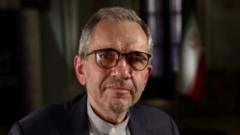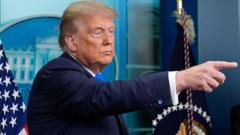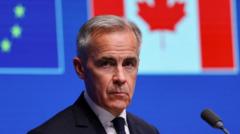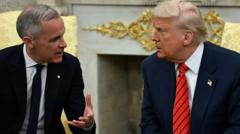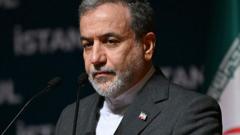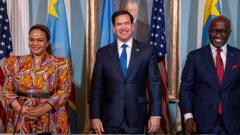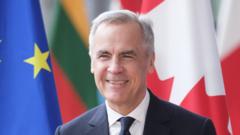**Amid ongoing trade negotiations, Canada signals interest in joining the United States’ proposed missile defense system, the Golden Dome, designed to counter next-gen aerial threats.**
**Canada Considers Collaboration on Trump's Ambitious Golden Dome Missile Defence Initiative**

**Canada Considers Collaboration on Trump's Ambitious Golden Dome Missile Defence Initiative**
**Prime Minister Carney engages in discussions with the US regarding a high-tech missile defense partnership amidst trade tensions.**
In a notable development, the Canadian government is exploring the possibility of joining the United States' ambitious "Golden Dome" missile defense initiative, designed to confront emerging aerial threats. Prime Minister Mark Carney's office confirmed active discussions between Canada and the US, indicating a focus on collaborative security strategies, including the Golden Dome project introduced by President Donald Trump.
The launch of this new missile defense concept, disclosed by Trump on Tuesday with an initial estimated investment of $25 billion, has captured Canadian interest. However, questions linger regarding the feasibility of the US implementing a comprehensive system and how Canada would structure its involvement and financial commitments.
This move by Canada occurs in the context of ongoing trade and security negotiations with the US, marked by Trump's recent threats of imposing substantial tariffs on Canadian goods and declarations advocating for Canada’s potential statehood under US governance. The rhetoric invigorated a wave of Canadian nationalism, significantly contributing to Carney’s recent successful election campaign.
Audrey Champoux, spokesperson for Prime Minister Carney, stated, “Canadians granted the prime minister a strong mandate for constructing a robust new security and economic framework with the United States.” She elaborated that discussions encompass strengthening existing initiatives like NORAD (North American Aerospace Defense Command) along with the Golden Dome endeavor. However, concrete details on Canada's financial contributions or operational methodology remain unclear at this juncture.
On the same day, Trump noted that Canada has shown eagerness to partake in the Golden Dome, affirming, "They want to have protection also, so as usual, we help Canada." The president projected that the missile defense program would be operational before the conclusion of his term, while also insisting on Canada's fair contribution.
Significantly, the non-partisan Congressional Budget Office has projected that the total expenditure for the system could skyrocket to $542 billion over two decades, particularly focusing on space-based components, raising eyebrows about its sustainability amidst budgetary constraints.
The existing NORAD partnership has been pivotal since 1958, providing aerospace and maritime surveillance capabilities across the region while detecting and neutralizing cruise missile threats. Recently, both nations have engaged in discussions to modernize this collaborative framework.
According to Trump, the Golden Dome aims to tackle advancing aerial threats, including hypersonic missiles, and will incorporate cutting-edge space-based sensors and interceptors capable of targeting missiles launched globally. The methodology for defense incorporates inspiration from Israel’s Iron Dome, a system known for intercepting missiles since its inception in 2011.
While experts acknowledge the ambition behind the Golden Dome, skepticism persists regarding the US's ability to establish an all-encompassing defense solution within the apparent timeline. Shashank Joshi, defense editor at the Economist, opined that feasible implementations may rely on a constellation of satellites for early detection and tracking, with interceptors launched from space. However, he cautioned that expectations of achieving comprehensive operational status during Trump's presidency are unrealistic, with the financial implications further straining the US defense budget.
The launch of this new missile defense concept, disclosed by Trump on Tuesday with an initial estimated investment of $25 billion, has captured Canadian interest. However, questions linger regarding the feasibility of the US implementing a comprehensive system and how Canada would structure its involvement and financial commitments.
This move by Canada occurs in the context of ongoing trade and security negotiations with the US, marked by Trump's recent threats of imposing substantial tariffs on Canadian goods and declarations advocating for Canada’s potential statehood under US governance. The rhetoric invigorated a wave of Canadian nationalism, significantly contributing to Carney’s recent successful election campaign.
Audrey Champoux, spokesperson for Prime Minister Carney, stated, “Canadians granted the prime minister a strong mandate for constructing a robust new security and economic framework with the United States.” She elaborated that discussions encompass strengthening existing initiatives like NORAD (North American Aerospace Defense Command) along with the Golden Dome endeavor. However, concrete details on Canada's financial contributions or operational methodology remain unclear at this juncture.
On the same day, Trump noted that Canada has shown eagerness to partake in the Golden Dome, affirming, "They want to have protection also, so as usual, we help Canada." The president projected that the missile defense program would be operational before the conclusion of his term, while also insisting on Canada's fair contribution.
Significantly, the non-partisan Congressional Budget Office has projected that the total expenditure for the system could skyrocket to $542 billion over two decades, particularly focusing on space-based components, raising eyebrows about its sustainability amidst budgetary constraints.
The existing NORAD partnership has been pivotal since 1958, providing aerospace and maritime surveillance capabilities across the region while detecting and neutralizing cruise missile threats. Recently, both nations have engaged in discussions to modernize this collaborative framework.
According to Trump, the Golden Dome aims to tackle advancing aerial threats, including hypersonic missiles, and will incorporate cutting-edge space-based sensors and interceptors capable of targeting missiles launched globally. The methodology for defense incorporates inspiration from Israel’s Iron Dome, a system known for intercepting missiles since its inception in 2011.
While experts acknowledge the ambition behind the Golden Dome, skepticism persists regarding the US's ability to establish an all-encompassing defense solution within the apparent timeline. Shashank Joshi, defense editor at the Economist, opined that feasible implementations may rely on a constellation of satellites for early detection and tracking, with interceptors launched from space. However, he cautioned that expectations of achieving comprehensive operational status during Trump's presidency are unrealistic, with the financial implications further straining the US defense budget.







